Deciphering Urban Land Use Patterns in the Shenzhen–Dongguan Cross-Boundary Region Based on Multisource Data
Abstract
:1. Introduction
2. Literature Review
3. Study Area, Data, and Methods
3.1. Study Area
3.2. Analytical Framework and Research Data
3.3. Research Methods
3.3.1. Identification and Conversion of Land Use Functions
- (1)
- Kernel
- (2)
- Chordal graph
- (3)
- Analytic Hierarchy Process (AHP)
3.3.2. The Mixing Degree of Land Use Functions
4. Results
4.1. Patterns of Spatial Growth in the Cross-Boundary Area
- (1)
- Dual-core-driven and peripheral synergy
- (2)
- Integration of two belts, spreading towards the center
- (3)
- Songshan Lake leads the rise in the central area
- (4)
- Network structure and region-wide balance
4.2. Spatial and Temporal Dimensions of Land Use Change in the Cross-Boundary Area
4.2.1. The Proportion and Transfer of Various Types of Land Use Functions
4.2.2. Evolution of Spatial Distribution Patterns of Various Types of Land Use Functions
- (1)
- Evolution of the overall distribution pattern
- (2)
- Evolution of industrial distribution patterns
4.2.3. Mixing Degrees of Land Use Functions
4.3. An Analysis of Factors Influencing the Functional Pattern of Land Use
4.3.1. Policy Guidance
- (1)
- Multi-functional mixing of various types of land use
- (2)
- Integration of industrial land use
4.3.2. Economic Factors
4.3.3. Transportation and Population Factors
4.3.4. Ecological Factors
5. Discussion
5.1. Exploration of Research Findings and Contributions
5.2. Future Development Orientation of the Region
5.3. Limitation
6. Conclusions
Author Contributions
Funding
Data Availability Statement
Acknowledgments
Conflicts of Interest
References
- Opinions on Further Improving the Regional Coordinated Development Pattern and Promoting the Accelerated High-Quality Development of Southern Towns; Dongguan Municipal Committee: Dongguan, China, 2020.
- Chen, T.; Li, X. Cross-Boundary Cooperation and Changes in the Roles of Governments at Different Levels in China: A Case Study of the Guangzhou-Foshan Metropolitan Area. China City Plan. Rev. 2023, 4, 73–83. [Google Scholar] [CrossRef]
- Dadashpoor, H.; Malekzadeh, N. Evolving Spatial Structure of Metropolitan Areas at a Global Scale: A Context-Sensitive Review. GeoJournal 2022, 87, 4335–4362. [Google Scholar] [CrossRef]
- Ding, C.; Zhao, X. Land Market, Land Development and Urban Spatial Structure in Beijing. Land Use Policy 2014, 40, 83–90. [Google Scholar] [CrossRef]
- Johnson, C.M. Cross-Border Regions and Territorial Restructuring in Central Europe: Room for More Transboundary Space. Eur. Urban Reg. Stud. 2009, 16, 177–191. [Google Scholar] [CrossRef]
- Darwent, D.F. Growth Poles and Growth Centers in Regional Planning—A Review. Environ. Plan. A Econ. Space 1969, 1, 5–31. [Google Scholar] [CrossRef]
- Friedmann, J. Regional Development Policy: A Case Study of Venezuela; M.I.T. Press: Cambridge, MA, USA, 1966. [Google Scholar]
- Wang, C.; Liu, H.; Zhang, M.; Wei, Z. The Border Effect on Urban Land Expansion in China: The Case of Beijing-Tianjin-Hebei Region. Land Use Policy 2018, 78, 287–294. [Google Scholar] [CrossRef]
- Landry, A. Borders and Big Macs. Econ. Lett. 2013, 120, 318–322. [Google Scholar] [CrossRef]
- Quazi Mahtab Zaman, G.G.H. Border Urbanism: Transdisciplinary Perspectives; Springer: Cham, Switzerland, 2023. [Google Scholar] [CrossRef]
- Lee, B. “Edge” Or “Edgeless” Cities? Urban Spatial Structure in U.S. Metropolitan Areas, 1980 to 2000*. J. Reg. Sci. 2007, 47, 479–515. [Google Scholar] [CrossRef]
- Sohn, C.; Stambolic, N. The Urban Development of European Border Regions: A Spatial Typology. Soc. Sci. Open Access Repos. 2015, 4, 177–189. [Google Scholar]
- Chen, T.; Hui, C.; Tu, Y.; Land, W. Growth or Shrinkage: Discovering Development Patterns and Planning Strategies for Cross-Border Areas in China. J. Urban Plann. Deve. 2019, 147, 05021046. [Google Scholar] [CrossRef]
- Basse, R.M.; Charif, O.; Bódis, K. Spatial and Temporal Dimensions of Land Use Change in Cross Border Region of Luxembourg. Development of a Hybrid Approach Integrating GIS, Cellular Automata and Decision Learning Tree Models. Appl. Geogr. 2016, 67, 94–108. [Google Scholar] [CrossRef]
- Hartshorne, R. The Twin City District: A Unique Form of Urban Landscape. Geogr. Rev. 1932, 22, 431. [Google Scholar] [CrossRef]
- Medeiros, E. Territorial Impact Assessment and Cross-Border Cooperation. Reg. Stud. Reg. Sci. 2015, 2, 97–115. [Google Scholar] [CrossRef]
- Awad, S.Q.; Ghadban, S.S.; Wannan, S.R. The Emergence of Al-Manarah Square as a New Centre for the Twin Cities of Ramallah and Al-Bireh. Urban Des. Int. 2018, 23, 200–214. [Google Scholar] [CrossRef]
- Donahue, M.L.; Keeler, B.L.; Wood, S.A.; Fisher, D.M.; Hamstead, Z.A.; McPhearson, T. Using Social Media to Understand Drivers of Urban Park Visitation in the Twin Cities, Mn. Landsc. Urban Plan. 2018, 175, 1–10. [Google Scholar] [CrossRef]
- Ortega, E.; Lopez, E.; Monzon, A. Territorial Cohesion Impacts of High-Speed Rail Under Different Zoning Systems. J. Transp. Geogr. 2014, 34, 16–24. [Google Scholar] [CrossRef]
- Durand, F. Challenges of Cross-Border Spatial Planning in the Metropolitan Regions of Luxembourg and Lille. Plan. Pract. Res. 2014, 2, 113–132. [Google Scholar] [CrossRef]
- Bičík, I.; Kabrda, J. Land Use Changes in Czech Border Regions (1845–2000). Acta Univ. Carol. Geogr. 2007, 42, 23–52. [Google Scholar]
- Peña, S. Land Use Planning on the U.S.-Mexico Border: A Comparison of the Legal Framework. J. Borderl. Stud. 2002, 17, 1–19. [Google Scholar] [CrossRef]
- Hui, E.C.M.; Li, X.; Chen, T.; Lang, W. Deciphering the spatial structure of China’s megacity region: A new bay area—The Guangdong-Hong Kong-Macao Greater Bay Area in the making. Cities 2020, 105, 102168. [Google Scholar] [CrossRef]
- Luo, X.; Shen, J. The Making of New Regionalism in the Cross-Boundary Metropolis of Hong Kong-Shenzhen, China. Habitat Int. 2012, 36, 126–135. [Google Scholar] [CrossRef]
- Zhou, X.; Lang, W.; Yeh, A.G.; Niu, X. Understanding the compactness of employment activities in high-density cities through cellphone location data. Environ. Plan. B Urban Anal. City Sci. 2021, 48, 1398–1413. [Google Scholar] [CrossRef]
- Tao, Y.; Wang, Q. Quantitative Recognition and Characteristic Analysis of Production-Living-Ecological Space Evolution for Five Resource-Based Cities: Zululand, Xuzhou, Lota, Surf Coast and Ruhr. Remote Sens. 2021, 13, 1563. [Google Scholar] [CrossRef]
- Deng, J.S.; Wang, K.; Hong, Y.; Qi, J.G. Spatio-Temporal Dynamics and Evolution of Land Use Change and Landscape Pattern in Response to Rapid Urbanization. Landsc. Urban Plan. 2009, 92, 187–198. [Google Scholar] [CrossRef]
- Liu, J.; Jin, X.; Xu, W.; Fan, Y.; Ren, J.; Zhang, X.; Zhou, Y. Spatial Coupling Differentiation and Development Zoning Trade-Off of Land Space Utilization Efficiency in Eastern China. Land Use Policy 2019, 85, 310–327. [Google Scholar] [CrossRef]
- Liu, Y.; Luo, T.; Liu, Z.; Kong, X.; Li, J.; Tan, R. A Comparative Analysis of Urban and Rural Construction Land Use Change and Driving Forces: Implications for Urban–Rural Coordination Development in Wuhan, Central China. Habitat Int. 2015, 47, 113–125. [Google Scholar] [CrossRef]
- Röder, A.; Pröpper, M.; Stellmes, M.; Schneibel, A.; Hill, J. Assessing Urban Growth and Rural Land Use Transformations in a Cross-Border Situation in Northern Namibia and Southern Angola. Land Use Policy 2015, 42, 340–354. [Google Scholar] [CrossRef]
- Lang, W.; Lang, H.; Hui, E.C.; Chen, T.; Wu, J.; Jahre, M. Measuring urban vibrancy of neighborhood performance using social media data in Oslo, Norway. Cities 2022, 131, 103908. [Google Scholar] [CrossRef]
- Du, Z.; Zhang, X.; Li, W.; Zhang, F.; Liu, R. A Multi-Modal Transportation Data-Driven Approach to Identify Urban Functional Zones: An Exploration Based on Hangzhou City, China. Trans. GIS 2020, 24, 123–141. [Google Scholar] [CrossRef]
- Yuan, N.J.; Zheng, Y.; Xie, X.; Wang, Y.; Zheng, K.; Xiong, H. Discovering Urban Functional Zones Using Latent Activity Trajectories. IEEE Trans. Knowl. Data Eng. 2015, 27, 712–725. [Google Scholar] [CrossRef]
- Lang, W.; Hui, E.C.; Chen, T.; Li, X. Understanding livable dense urban form for social activities in transit-oriented development through human-scale measurements. Habitat Int. 2020, 104, 102238. [Google Scholar] [CrossRef]
- Gao, S.; Janowicz, K.; Couclelis, H. Extracting Urban Functional Regions from Points of Interest and Human Activities on Location-Based Social Networks. Trans. GIS 2017, 21, 446–467. [Google Scholar] [CrossRef]
- Huang, C.; Xiao, C.; Rong, L. Integrating Point-of-Interest Density and Spatial Heterogeneity to Identify Urban Functional Areas. Remote Sens. 2022, 14, 4201. [Google Scholar] [CrossRef]
- Lang, W.; Pan, M.; Wu, J.; Chen, T.; Li, X. The patterns and driving forces of uneven regional growth in ASEAN countries: A tale of two Thailands’ path toward regional coordinated development. Growth Change A J. Urban Reg. Policy 2021, 52, 130–149. [Google Scholar] [CrossRef]
- Niu, H.; Silva, E.A. Delineating Urban Functional Use from Points of Interest Data with Neural Network Embedding: A Case Study in Greater London. Comput. Environ. Urban Syst. 2021, 88, 101651. [Google Scholar] [CrossRef]
- Zhou, W.; Ming, D.; Lv, X.; Zhou, K.; Bao, H.; Hong, Z. So–Cnn Based Urban Functional Zone Fine Division with Vhr Remote Sensing Image. Remote Sens. Environ. 2020, 236, 111458. [Google Scholar] [CrossRef]
- Kang, Y.H.; Wang, Y.Y.; Xia, Z.J.; Chi, J.; Jiao, L.M.; Wei, Z.W. Identification and Classification of Wuhan Urban Districts Based on POI. J. Geomat. 2018, 43, 81–85. [Google Scholar]
- The International Congresses of Modern Architecture (CIAM). The Charter of Machu Picchu. J. Archit. Res. 1979, 7, 5–9. [Google Scholar]
- Pérez-Soba, M.; Petit, S.; Jones, L.; Bertrand, N.; Briquel, V.; Omodei-Zorini, L.; Contini, C.; Helming, K.; Farrington, J.H.; Mossello, M.T.; et al. Land Use Functions—a Multifunctionality Approach to Assess the Impact of Land Use Changes on Land Use Sustainability. Sustain. Impact Assess. Land Use Changes 2008, 375–404. [Google Scholar] [CrossRef]
- Dovey, K.; Pafka, E. What is Functional Mix? An Assemblage Approach. Plan. Theory Pract. 2017, 18, 249–267. [Google Scholar] [CrossRef]
- Purvis, B.; Mao, Y.; Robinson, D. Entropy and its Application to Urban Systems. Entropy 2019, 21, 56. [Google Scholar] [CrossRef]
- Yang, J.; Huang, X. The 30 M Annual Land Cover Dataset and its Dynamics in China From 1990 to 2019. Earth Syst. Sci. Data 2021, 13, 3907–3925. [Google Scholar] [CrossRef]
- GB 50137-2011; Code for Classification of Urban Land Use and Planning Standards of Development Land. Ministry of Housing and Urban-Rural Development: Beijing, China, 2010. Available online: https://www.planning.org.cn/law/uploads/2013/1383993139.pdf (accessed on 3 April 2023).
- Borruso, G. Network Density Estimation: A Gis Approach for Analysing Point Patterns in a Network Space. Trans. GIS 2008, 12, 377–402. [Google Scholar] [CrossRef]
- Zhao, W.F.; Li, Q.Q.; Li, B.J. Extracting hierarchical landmarks from urban POI data. Natl. Remote Sens. Bull. 2011, 15, 973–988. [Google Scholar]
- Huang, Y.H.; Liu, H.Y.; Deng, S.H.; Chen, H.S. Cross Boundary Programming of Shenzhen-Dongguan-Huizhou Metropolitan Area from the Perspective of Balanced Development. Planners 2022, 38, 52–60. [Google Scholar]
- National Plan on New Urbanization; The Central Committee of the Communist Party of China (CPC) and the State Council: Beijing, China, 2014.
- Several Opinions on Further Strengthening the Management of Urban Planning and Construction; The Central Committee of the Communist Party of China (CPC) and the State Council: Beijing, China, 2016.
- Several Opinions on Expanding and Optimizing Urban Development Space and Accelerating the Promotion of High-Quality Development; The People’s Government of Dongguan Municipality: Dongguan, China, 2019.
- Shenzhen Territorial Spatial Masterplan (2020–2035); Shenzhen Planning and Natural Resources Bureau: Shenzhen, China, 2021.
- The 14th Five-Year Plan for the Protection and Development of Territorial Spatial Planning in Shenzhen Municipality; The People’s Government of Shenzhen Municipality: Shenzhen, China, 2022.
- Opinions on Supporting Guangdong, Hong Kong and Macao Bay Area and Shenzhen Municipality to Deepen Reform and Exploration in the Field of Natural Resources; Ministry of Natural Resources, People’s Republic of China: Beijing, China, 2020.
- Reitel, B. Les Agglomérations Transfrontalières: Des Systèmes Urbains En Voie D’intégration?: Les Espaces Urbains De La “Frontière” Du Territoire Français. Geogr. Helv. 2007, 62, 5–15. [Google Scholar] [CrossRef]
- Anishenko, A.G.; Sergunin, A.A. Twin Cities: A New Form of Cross-Border Cooperation in the Baltic Sea Region? Baltic Region. 2012, 4, 19–27. [Google Scholar] [CrossRef]
- Ersavaş Kavanoz, S.; Erdem, N. The Sister City in the Context of City Entrepreneurship in the Glocal Process: The Sample of Trabzon-Zigetvar. Int. J. Political Sci. Urban Stud. 2019, 7, 191–208. [Google Scholar] [CrossRef]
- Tsui Auch, L.S. Regional Production Relationships and Developmental Impacts: A Comparative Study of Three Production Networks. Int. J. Urban Reg. Res. 2002, 23, 329–344. [Google Scholar] [CrossRef]
- Buursink, J. The Binational Reality of Border-Crossing Cities. GeoJournal 2001, 54, 7–19. [Google Scholar] [CrossRef]
- Eaton-Gonzalez, R.; Mellink, E. One Shared Region and Two Different Change Patterns: Land Use Change in the Binational Californian Mediterranean Region. Land 2015, 4, 1138–1154. [Google Scholar] [CrossRef]
- Ojeda-Revah, L.; Bocco, G.; Ezcurra, E.; Espejel, I. Land-Cover/Use Transitions in the Binational Tijuana River Watershed during a Period of Rapid Industrialization. Appl. Veg. Sci. 2008, 11, 107–116. [Google Scholar] [CrossRef]
- Jessop, B.; Sum, N. An Entrepreneurial City in Action: Hong Kong’s Emerging Strategies in and for (Inter)Urban Competition. Urban Stud. 2000, 37, 2287–2313. [Google Scholar] [CrossRef]
- Dai, L.; Zhan, Z.; Shu, Y.; Rong, X. Land Use Change in the Cross-Boundary Regions of a Metropolitan Area: A Case Study of Tongzhou-Wuqing-Langfang. Land 2022, 11, 153. [Google Scholar] [CrossRef]
- Lin, J.; Wu, W. Investigating the Land Use Characteristics of Urban Integration Based on Remote Sensing Data: Experience from Guangzhou and Foshan. Geocarto Int. 2019, 34, 1608–1620. [Google Scholar] [CrossRef]
- Huang, Y.; Lang, W.; Chen, T.; Wu, J. Regional Coordinated Development in the Megacity Regions: Spatial Pattern and Driving Forces of the Guangzhou-Foshan Cross-Border Area in China. Land 2023, 12, 753. [Google Scholar] [CrossRef]
- Lang, W.; Long, Y.; Chen, T. Rediscovering Chinese cities through the lens of land-use patterns. Land Use Policy 2018, 79, 362–374. [Google Scholar] [CrossRef]
- Ullman, E.L. American Commodity Flow; University of Washington Press: Seattle, WA, USA, 1957. [Google Scholar]
- Outline Development Plan for the Guangdong-Hong Kong-Macao Greater Bay Area; The Central Committee of the Communist Party of China (CPC) and the State Council: Beijing, China, 2019.
- Sohn, C. The Border as a Resource in the Global Urban Space: A Contribution to the Cross-Border Metropolis Hypothesis. Int. J. Urban Reg. Res. 2014, 38, 1697–1711. [Google Scholar] [CrossRef]



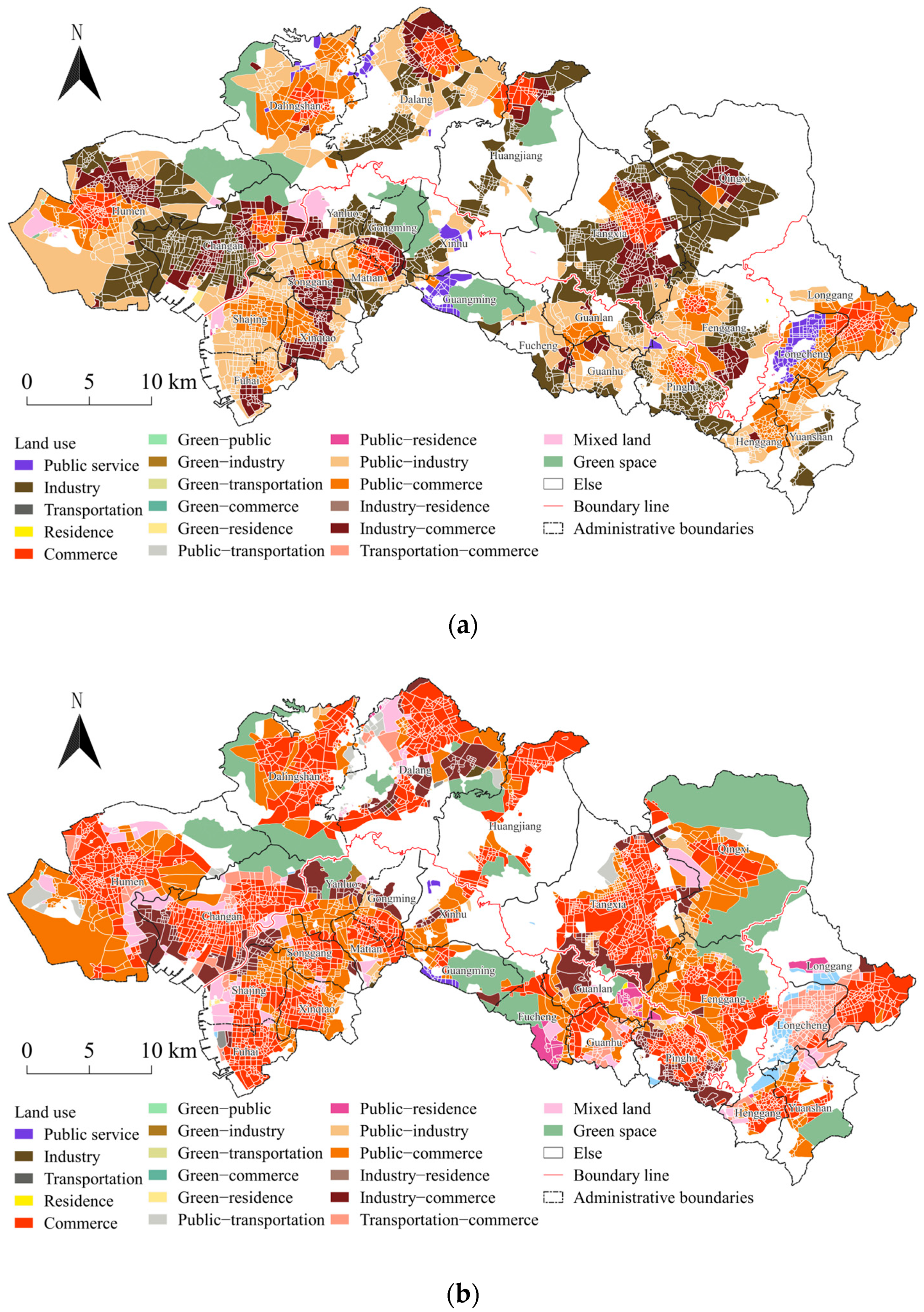
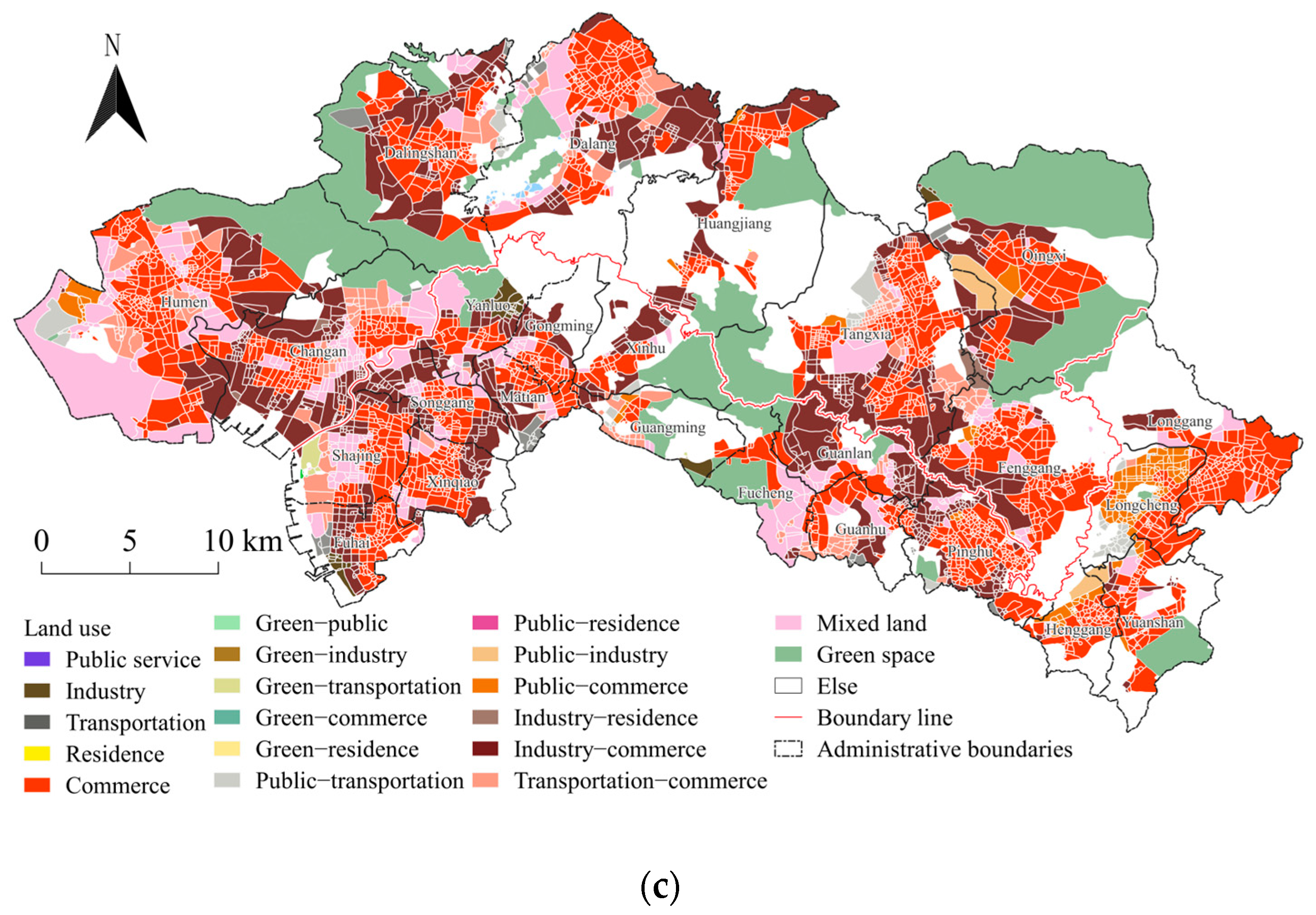
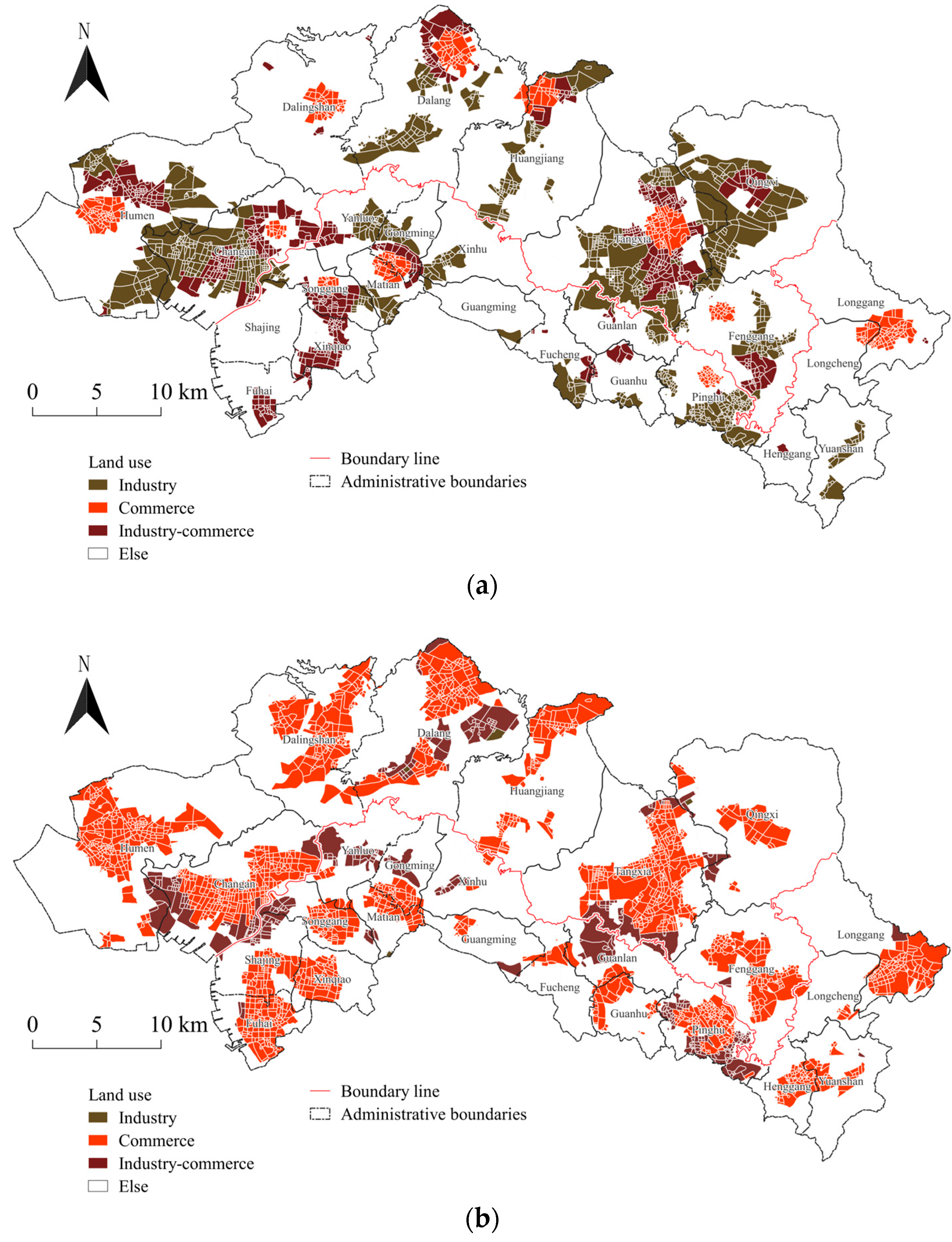
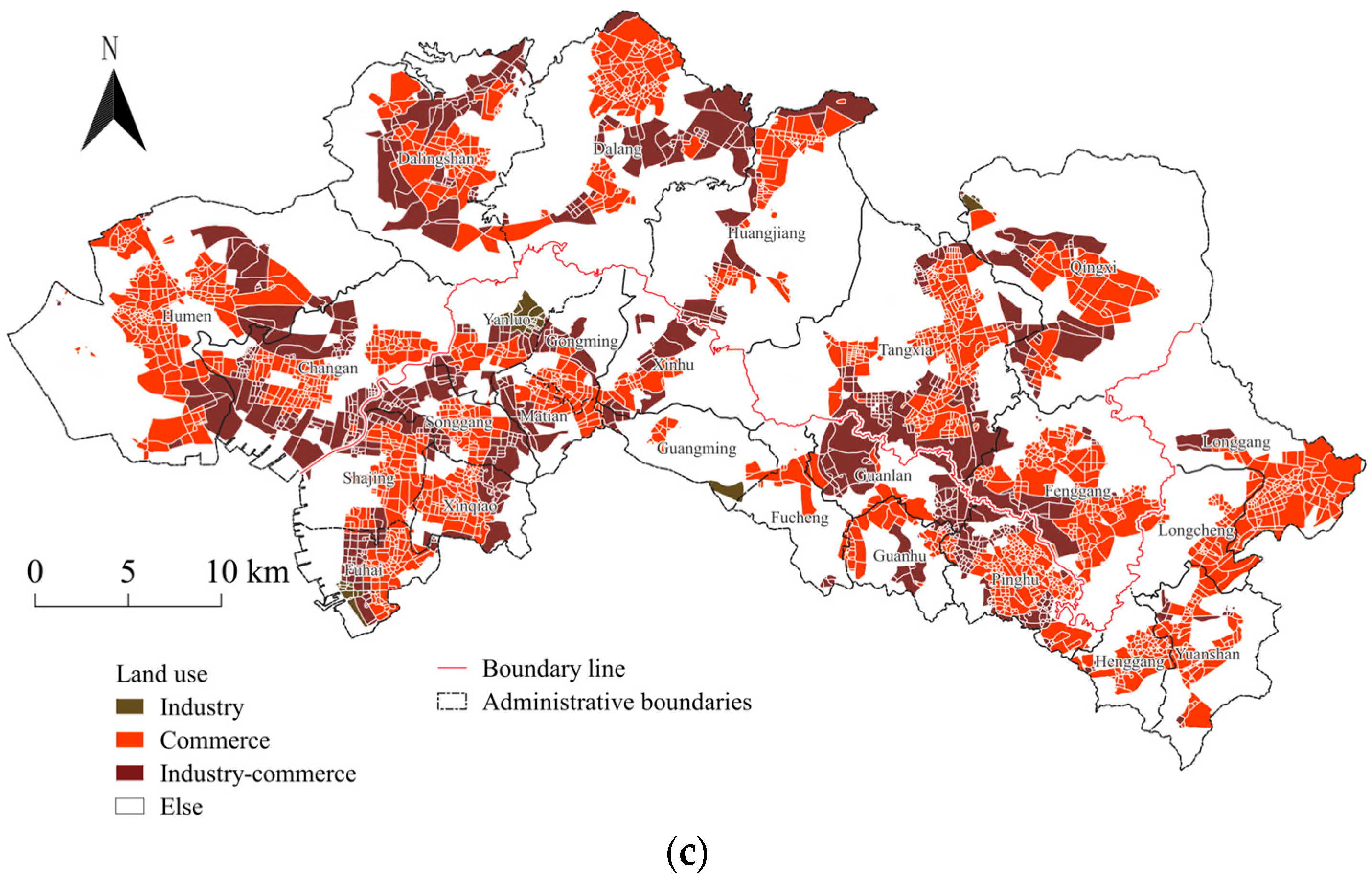


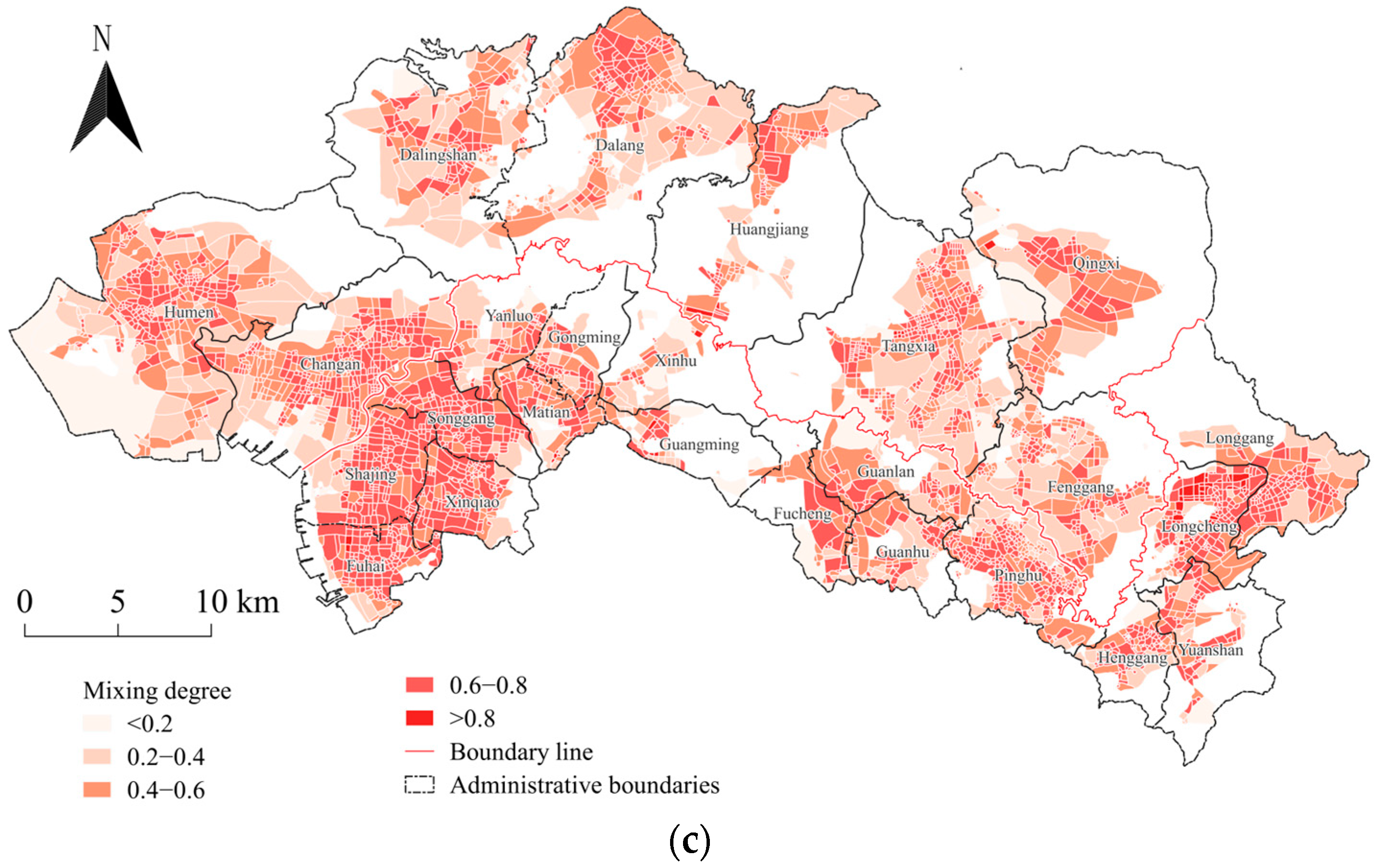
| Data | Source | Introduction | Pretreatment |
|---|---|---|---|
| Land use data | National Earth System Science Data Center [45] | The data type is a 30 m × 30 m grid divided into nine categories: farmland, forests, shrubs, grasslands, water bodies, ice and snow, bare land, impermeable surfaces, and wetlands. Among them, impermeable surfaces refer to surfaces covered by impermeable materials, including surfaces with low permeability such as building roofs, parking lots, and roads, which can represent the level of urbanization. | Extract impermeable water bands, re project, and crop |
| Night light data | National Environmental Information Center (NCEI) Earth Observation Group (https://eogdata.mines.edu/products/vnl/, (accessed on 17 March 2023)) | Representing the level of regional socio-economic development, it can reflect social and economic factors such as population concentration, urbanization, and economic activity. | Based on the consistency of time resolution, perform data correction between DMSP-OLS data and SNPP-VIIRS data |
| POIs | Gaode Map API (https://console.amap.com/dev/index, (accessed on 3 April 2023)) | Data are real-time, dynamic, easily obtainable, high in accuracy, and have strong practical significance. Density analysis of various POIs can be used to describe the distribution of various types of land or facilities in urban space. Commonly used POIs include multiple categories such as residential, commercial, public facilities, and transportation. | There is cross-duplication between the original POI data types, resulting in data redundancy. Therefore, the operations of reclassifying, filtering, and removing outliers are necessary |
| Road network data | OpenStreetMap (https://www.openstreetmap.org, (accessed on 3 April 2023)) | As the “natural boundary” of a city, the irregular grid units formed by the road network are the basic units for formulating urban planning, dividing urban socio-economic functions, and undertaking urban service management. | Buffer zone analysis, dual line to single line conversion, pruning of suspended roads, road extension, and a series of topology corrections; partition density calculation |
| Primary Classification | Secondary Classification | Three Level Classification |
|---|---|---|
| Residence | Business residential (residential areas, commercial-residential related) | Residential communities, villas, apartments, dormitories, etc. |
| Public Service | Public facilities, science and education, cultural services, healthcare services, government agencies and social organizations, living services, sports, and leisure services | Government agencies, clinics, hospitals, schools, libraries, museums, community reading centers, exhibition centers, nursing homes, elderly activity centers, etc. |
| Commerce | Life services, commercial residential buildings, catering, shopping, financial and insurance services, sports and leisure services, accommodation services, companies, and enterprises | Supermarkets, shopping centers, restaurants, hotels, banks, commercial office buildings, insurance companies, consulting companies, commercial companies, etc. |
| Industry | Corporate enterprises, commercial-residential (industrial parks) | Companies, enterprises, factories, science and technology parks, industrial parks, logistics parks, etc. |
| Transportation | Transportation facility services | Parking lots, bus stops, bus stops, service areas, etc. |
| Green Space | Scenic spot | Parks, squares, tourist attractions, etc. |
| Land Use Type | 2008 | 2014 | 2022 | |||
|---|---|---|---|---|---|---|
| Quantity | Percentage | Quantity | Percentage | Quantity | Percentage | |
| Mixed land | 45 | 0.80 | 269 | 4.78 | 665 | 11.82 |
| Green space | 29 | 0.52 | 34 | 0.60 | 44 | 0.78 |
| Public Service | 295 | 5.24 | 25 | 0.44 | 0 | 0.00 |
| Industry | 1430 | 25.42 | 12 | 0.21 | 55 | 0.98 |
| Transportation | 1 | 0.02 | 14 | 0.25 | 5 | 0.09 |
| Residence | 4 | 0.07 | 4 | 0.07 | 4 | 0.07 |
| Commerce | 630 | 11.20 | 2860 | 50.84 | 2710 | 48.18 |
| Green-Public | 16 | 0.28 | 6 | 0.11 | 0 | 0.00 |
| Green-Industry | 11 | 0.20 | 13 | 0.23 | 5 | 0.09 |
| Green-Transportation | 3 | 0.05 | 12 | 0.21 | 37 | 0.66 |
| Green-Residence | 11 | 0.20 | 15 | 0.27 | 2 | 0.04 |
| Green-Commerce | 0 | 0.00 | 0 | 0.00 | 2 | 0.04 |
| Public-Industry | 1254 | 22.29 | 135 | 2.40 | 3 | 0.05 |
| Public-Transportation | 3 | 0.05 | 122 | 2.17 | 152 | 2.70 |
| Public-Residence | 45 | 0.80 | 90 | 1.60 | 6 | 0.11 |
| Public-Commerce | 962 | 17.10 | 1076 | 19.13 | 215 | 3.82 |
| Industry-Transportation | 0 | 0.00 | 13 | 0.23 | 89 | 1.58 |
| Industry-Residence | 4 | 0.07 | 0 | 0.00 | 12 | 0.21 |
| Industry-Commerce | 882 | 15.68 | 482 | 8.57 | 1153 | 20.50 |
| Transportation-Residence | 0 | 0.00 | 123 | 2.19 | 44 | 0.78 |
| Transportation-Commerce | 0 | 0.00 | 320 | 5.69 | 422 | 7.50 |
| Policy | Unit | Year | Main Content |
|---|---|---|---|
| National Plan on New Urbanization (2014–2020) | The Central Committee of the Communist Party of China (CPC) and the State Council | 2014 | Strengthen the transformation of urban functions in existing development zones and promote the transformation from single production functions to comprehensive urban functions. |
| Several Opinions on Further Strengthening the Management of Urban Planning and Construction | 2016 | Create a convenient and fast lifestyle circle. | |
| Several Opinions on Expanding and Optimizing Urban Development Space and Accelerating the Promotion of High-Quality Development | The People’s Government of Dongguan Municipality | 2019 | Encourage a moderate increase in land development intensity and mixed and three-dimensional composite utilization of land use; accelerate the improvement of the implementation mechanism for mixed land use; encourage the mixed use of public management and service facility land, transportation facility land, urban green space, and various types of land; and support the allocation of a certain proportion of commercial office, supporting residential and public service facility land for new industrial land (M0). |
| Shenzhen Territorial Spatial Masterplan (2020–2035) | Shenzhen Planning and Natural Resources Bureau | 2021 | Promote the three-dimensional development and utilization of cities and the mixing of functions; build diverse urban complexes; promote the comprehensive development of TOD models; encourage the integration of building functions; and stimulate the vitality of production and living spaces. |
| The 14th Five-Year Plan for the Protection and Development of Territorial Spatial Planning in Shenzhen Municipality | The People’s Government of Shenzhen Municipality | 2022 | Encourage the integration of building functions, create a diverse, convenient, and compact space that integrates businesses and offices, education and research, public services, cultural and entertainment functions, and stimulate the vitality of urban life and production space. |
Disclaimer/Publisher’s Note: The statements, opinions and data contained in all publications are solely those of the individual author(s) and contributor(s) and not of MDPI and/or the editor(s). MDPI and/or the editor(s) disclaim responsibility for any injury to people or property resulting from any ideas, methods, instructions or products referred to in the content. |
© 2024 by the authors. Licensee MDPI, Basel, Switzerland. This article is an open access article distributed under the terms and conditions of the Creative Commons Attribution (CC BY) license (https://creativecommons.org/licenses/by/4.0/).
Share and Cite
Wu, L.; Lang, W.; Chen, T. Deciphering Urban Land Use Patterns in the Shenzhen–Dongguan Cross-Boundary Region Based on Multisource Data. Land 2024, 13, 161. https://doi.org/10.3390/land13020161
Wu L, Lang W, Chen T. Deciphering Urban Land Use Patterns in the Shenzhen–Dongguan Cross-Boundary Region Based on Multisource Data. Land. 2024; 13(2):161. https://doi.org/10.3390/land13020161
Chicago/Turabian StyleWu, Likun, Wei Lang, and Tingting Chen. 2024. "Deciphering Urban Land Use Patterns in the Shenzhen–Dongguan Cross-Boundary Region Based on Multisource Data" Land 13, no. 2: 161. https://doi.org/10.3390/land13020161






